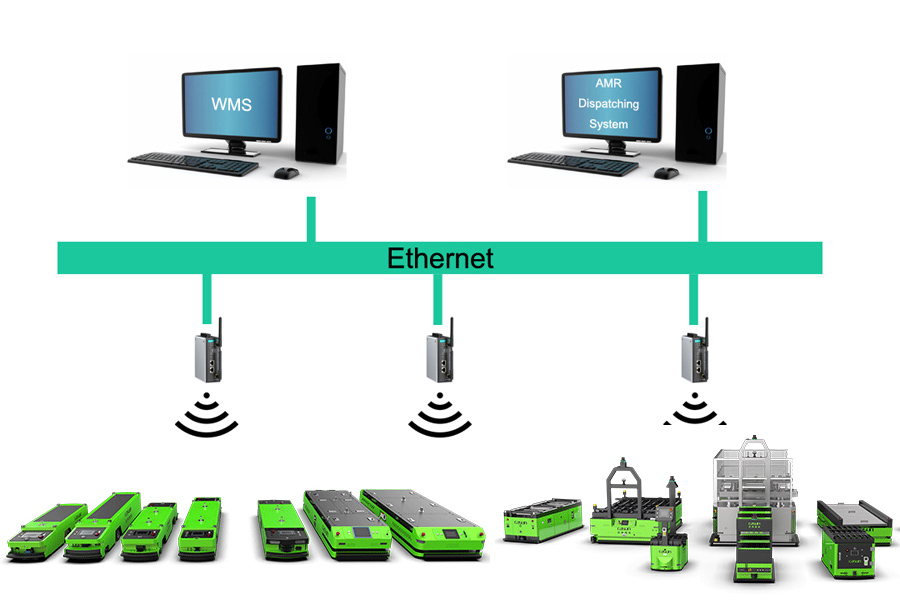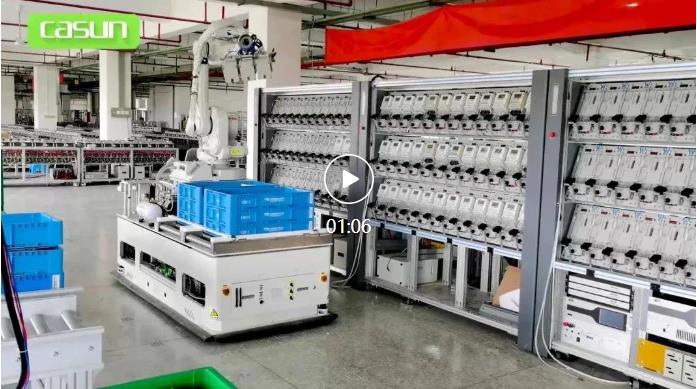Contents
Operational performance test
Under the applicable environmental conditions of the AMR, test whether the AMR can reach the specified load capacity and speed after being fully charged.
- 1.1 Rated speed test: The test passes the time in the interval of 15m or more from the point after the speed is stable on the straight line, and the rated speed is calculated based on the measured time and distance. The test is not less than 10 times, and the data is taken as the arithmetic average value: it is carried out under the condition of rated load, forward and backward (except without backward function).
The deviation between the measured actual speed and the theoretical value is acceptable within the accuracy range of the encoder, otherwise, it does not meet the requirements.
- 1.2 Motion accuracy test: Make an error mark in advance in the specified straight-line guide trajectory section. When the AMR moves on the guidance route at a prescribed speed, the tester visually reads the maximum deviation from the baseline. The test is carried out under the condition of no-load and specified load, forward and backward (except without the reverse function), and the motion accuracy shall not exceed the value specified by the manual.
- 1.3 Normal parking test: From the specified speed to the normal stop state on the linear motion trajectory, test the deviation of the AMR from the ground baseline from front to back and left to the right after parking. The parking accuracy shall not exceed the value specified by the manual.
- 1.4 Rotation test: Automatically run at the set speed on the curve of the minimum radius of rotation of the guideline specified by the AMR, and rotate smoothly on the guide track. The transition between the various factions of the AMR is required to be smooth. The test is performed under no load and with Test separately under specified load conditions.
Safety performance test
- 2.1 Contact obstacle buffer performance test: turn off the safety laser scanner of the AMR, the AMR runs at the rated speed, and the obstacle is placed in the direction of the AMR (diameter 50mm, weight below 55kg) after the AMR in motion hits the obstacle stop. Test the moving distance that is forced to stop, repeat the test 5 times, the test is carried out separately under no load and under load, and the braking distance shall not exceed the specified value.
- 2.2 Emergency stop performance test: The AMR runs automatically at rated speed. After pressing the emergency stop button at the pre-marked place on the straight track, the AMR stops in an emergency and tests the distance from the marked position to the parking position. The test is carried out at no load and with regulations. Under load, forward, and reverse (except without reverse function), each test 5 times, and the braking distance must not exceed the specified value.
- 2.3 Alarm device performance test: Under the automatic movement state, confirm that the following various alarm devices work:
- Automatic operation indicator light: When the AMR is in operation, the automatic operation indicator light should start normally,
- Start alarm: When the AMR is started from the stopped state, the audible alarm should be activated for 3s before the AMR can be started,
- Steering alarm: When the AMR turns or changes lanes, the AMR should activate the steering alarm,
- Abnormal alarm: When the AMR is in a low battery state or derailed or other abnormal conditions, the AMR should initiate an abnormal alarm.
Load device performance test
Under automatic or manual operation, confirm that the specified load exchange (loading or unloading) can be successfully completed, and there should be no abnormal jams, loading, unloading abnormal, etc.
When the load exchange is abnormal, the performance test of the interlocking device: in the automatic or manual state, when it is confirmed that the specified load exchange (loading or unloading) cannot be carried out normally, when the lifting system rises or falls does not reach the specified position, the AMR alarms, and stops running.
Rated power test
After the AMR battery is discharged, it is connected to the charging station through a power meter, and the input current of the AMR is recorded. The input rating of the AMR shall not exceed 10% of the rating specified by the manual.
Power failure, power restoration test
- 5.1 The AMR with the rated load moves in a predetermined manner, and the switch is turned off to power off the AMR. The AMR should perform an emergency stop and should not leave the original position, and should not cause the load to move or fall from its reserved position.
- 5.2 The AMR should also be tested during the raising or lowering process, and the switch should be turned off to turn off the power supply. The lifting mechanism must not continue to move, nor should the load fall from the position it holds.
- 5.3 Perform the opposite test according to the description in 1 and 2 above, verify by power restoration, turn on the switch, and do not allow the AMR or load handling actuator to move automatically, or cause any load to fall or leave from its reserved position.
Test result judgment: The AMR should enter the emergency stop state when the power is cut off, and stop the movement safely. After the power supply is restored, the AMR should not be allowed to automatically move or release the reserved load.
Brake test
Test method: Fully charge the AMR and run it on a horizontal surface with maximum acceleration under rated load conditions. Every 30 meters (100 feet), press the emergency stop to stop the AMR completely through the brake. Repeat this test until the test time reaches 2 hours or until the power supply is discharged, whichever occurs first.
Test result judgment: During the test, the outer surface temperature of the brake should not exceed 175°C (347°F) in an ambient temperature of 25°C (77°F). The brake must not ignite or generate flames or sparks
Stability test
- 7.1 The AMR has the maximum rated load, and the load will be distributed on the AMR in the most unbalanced manner for testing. For an AGV equipped with a load handling actuator, the actuator should be at its maximum extension (lifting AMR is at its highest lifting position).
- 7.2 The AMR is configured as described in 1, and the AMR should be inclined at an angle of 10 degrees in the vertical direction. If the AMR is too heavy to be easily tilted at an angle of 10 degrees, a rising slope can be placed to tilt the AMR at an angle of 10 degrees in the vertical direction.
- 7.3 The AMR is configured according to the description in 1, the AMR should withstand a force of 800N in any direction (except upwards) at any point, at any point on the AMR, including the highest point not more than 1 meter (3 feet) above the ground.
- 7.4 The AMR is configured as described in 1, and the AMR runs at the maximum speed on the maximum allowable slope
Test result judgment: AMR should not lose its balance during the above test
Lifting equipment load test
- 8.1 When the AMR is provided with eye bolts or similar devices for lifting or transportation, it should be able to withstand twice the weight of the AMR’s maximum load and hold it for 5 minutes.
The test result judges: the lifting or fixing device and its accessory shell should not show any deformation or damage.
- 8.2 Place a heavy object equal to 1.15 times the mass of the rated load on the AMR carrying platform and run it in the most unfavorable way for 3 times,
Test result judgment: observe whether the AMR has permanent deformation and whether it can operate normally
- 8.3 Place a weight equivalent to 1.25 times the mass of the rated load on the AMR and let it stand for 15 minutes.
Test result judgment: After the test, the AMR should be able to carry the load and work normally without permanent deformation, out of control and other dangerous situations
Anti-collision device activation test
- 9.1 Fix the dynamometer horizontally on the AMR with the same height as the anti-collision device.
- 9.2 Specimen A with a diameter of 200mm and a length of 600mm, weighing 55kg (simulating the state of lying down), is placed horizontally at any position at right angles to the path of the vehicle. (Placement position as shown above)
- 9.3 Specimen B with a diameter of 70mm and a height of 400mm, weighs 55kg (simulating a human calf), and is installed vertically at any position in the vehicle path. (Placement position as shown above)
- 9.4 The AMR carries a rated load, runs at the maximum speed and makes the dynamometer hit the obstacle so that the AMR stops running.
Test result judgment: the force of specimen A shall not exceed 750N; the force of specimen B shall not exceed 400N;
Safety scanner: the detection distance for generating the trigger signal should meet the requirements specified by the manual.

